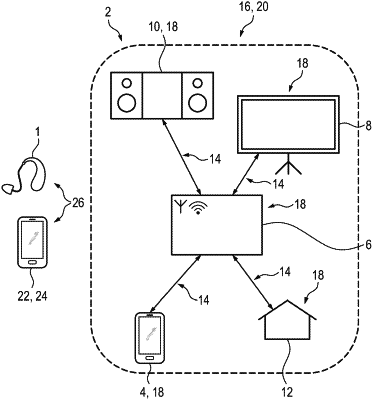| CPC H04R 25/70 (2013.01) [H04R 25/505 (2013.01); H04R 25/554 (2013.01)] | 18 Claims |

|
1. A method of automatically setting at least one parameter for signal processing in a hearing device, the method comprising:
examining immediate surroundings of the hearing device for a presence of at least one node of a wireless communication network, wherein a node that is detected as being present is a detected node;
ascertaining characteristic information of the detected node;
comparing the characteristic information of the detected node with a first dataset of first characteristic information respectively stored beforehand for nodes that are marked as known, and concluding whether the detected node is a known node or an unknown node;
using the characteristic information of the detected node as a basis for setting the at least one parameter for the signal processing of the hearing device;
if the node detected as present is determined to be a known node based on the characteristic information then the at least one parameter of the signal processing of the hearing device is set on the basis of second characteristic information that is dependent on the known node and was stored in a second dataset beforehand on the basis of the known node;
defining a plurality of known electronic surroundings that respectively exist as a result of a simultaneous presence of a number of specific known nodes;
using the second characteristic information defined for at least one of the electronic surroundings as the setting of the parameter of the signal processing of the hearing device, and storing the setting in the second dataset;
performing an analysis with regard to a presence of one of the known electronic surroundings defined beforehand; and
if one of the known electronic surroundings defined beforehand is present, using the applicable second characteristic information as a basis for setting the parameter for the signal processing of the hearing device.
|